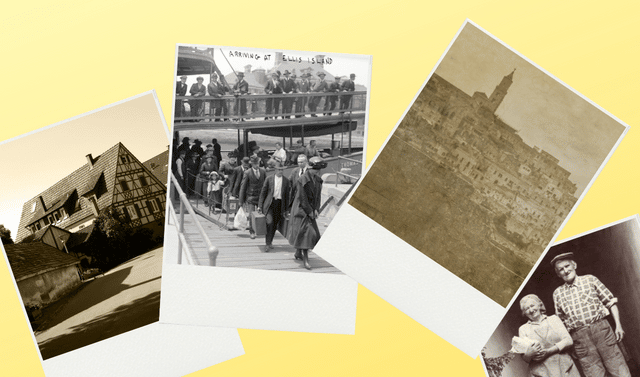When you start exploring a new-to-you homeland, it’s easy to feel a bit lost. You don’t know what records are available, or how to find and access them. If the records are in another language, you may not know how to read them. And if the history or culture is unfamiliar, you can’t place your family’s experience in a wider context.
In fact, exploring your family history in a foreign homeland is not unlike planning to travel there. Travelers spend a lot of time looking at maps, learning new words, and absorbing local lore. But if you were actually traveling there, you could learn your way around from expert guides, fellow travelers, and the locals.
For some homelands, expert genealogy guides are available—in fact, they appear regularly in the pages of Family Tree Magazine and on our website (see Explore by Place rom the main menu). But if your ancestors came from farther-flung places, you may struggle to find current, comprehensive how-to resources. And even if you can find guides, you may wonder what you’re missing.
Here, we offer a whirlwind tour of wikis and web resources to help you find ancestors from anywhere—including places that don’t tend to be covered by how-to genealogy guides. We’ll point to records, repositories, how-to resources, and online communities that provide research paths from Nigeria to New Zealand, Costa Rica to Croatia, and anywhere in between.
Start with the FamilySearch Wiki
“Wikipedia for genealogists”: that’s the easiest way to describe the FamilySearch Research Wiki. FamilySearch is the world’s biggest free genealogy website. Its Research Wiki (under Search > Research Wiki) has more than 100,000 articles on topics pertaining to 250-plus countries.
An interactive map on the home page helps you immediately target your region of interest. Click List of All Localities for an alphabetized list of countries, or a continent name to see what’s available for that region; the sideways arrow indicates the Wiki has drill-down options. The Guided Research button at top-right connects you to a growing collection of country-based starter guides, with special focus on birth, marriage and death records.
The country-level landing pages (such as Ghana’s, above) offer a lot to see and do. Don’t be afraid to click on everything:
- Country Information, including neighboring places and past names
- Getting Started, a series of short articles that orient you to the essentials
- Online Genealogy Records: record collections on FamilySearch and beyond
- Ask the Community, a discussion forum with experts and other researchers
- Research Tools, which collects links to articles, foreign-language letter-writing guides, word lists, and more
- Wiki Topics (at right) include quick links to research aids such as Record Finder, record-specific articles, and information about history both social (History) and geographical (Maps, Jurisdictions, Gazetteers)
- Finding Town of Origin, which has tips for identifying a specific hometown
In general, the options on a landing page vary by country. Because the FamilySearch Research Wiki is a crowd-sourced platform, some articles are more complete, accurate and up-to-date than others. But overall, the Research Wiki is an excellent starting point for researching new places.
Watch our guided tour of the FamilySearch Research Wiki. You’ll also find helpful video tutorials through FamilySearch’s Learning Center.
Consult Other Genealogy Guides
The FamilySearch Wiki is by no means the only—or even the best—resource for every homeland. What follows are jumping-off points for exploring other websites. Pay attention to the strategies, record collections and websites they most often recommend.
General web search
Try a keyword search for the country and the word genealogy. Top search results will likely include landing pages on major genealogy websites. But you may also find results like the kind that come up in a Google search for Finland genealogy: three Finnish research societies and several how-to articles, including one from Family Tree Magazine.
Pro tip: If you find a site in a language that you don’t speak, look for site-translation browser extensions or use a browser (such as Google Chrome) that will translate it for you. Auto-translation isn’t perfect, but it may be good enough for your needs.
Cyndi’s List
Browse the 320,000 categorized, cross-referenced links at this standard-bearer of a site. Under Categories, look under both countries and continent or global region (such as Africa, Baltic States, and Central and South America). Site founder Cyndi Ingle was interviewed in a July 2023 episode of the Family Tree Magazine podcast; listen here.
If you don’t immediately see what you’re looking for, try the Google search box in the upper right. A search there for Taiwan, for example, leads you to the “China, Hong Kong & Taiwan” category. Also visit the Facebook category to find social communities for discussing various parts of the world.
WorldGenWeb Project
This free website hosts a collection of pages for dozens of countries, from Albania to Zimbabwe. Each is coordinated by volunteers who contribute local knowledge. The country pages hold information about online records, repositories, maps, history, and message boards or mailing lists to connect you with fellow researchers.
Geneanet
On this freemium resource, more than 5 million members have documented about 8 billion individuals in family trees. You’ll also find some records and other resources. The other languages available on Geneanet—French, German, Italian, Norwegian, Finnish, Swedish, Portuguese, Spanish and Dutch—hint at the European strength of this site, which was acquired by Ancestry.com in 2021. Learn more.
The Library of Congress
This mainstay has published Handbooks for Foreign Genealogical Research, Library of Congress, a bibliography of print how-to genealogy guides for areas around the world. Choose the appropriate global region and browse the list of available titles by country. Order copies of books you want through your favorite booksellers or search for copies to borrow through libraries at WorldCat.
Note: Even if outdated, printed guides can be excellent sources for history and records. Supplement what you learn there with more recently updated information online about how to access records today.
Key Place Details
Ask yourself these questions when studying a new ancestral homeland:
- Was the country or region once part of a different nation-state? For example: part of the Soviet Union, a colony of Spain, or a city-state within the Holy Roman Empire?
- When did vital record-keeping begin? Religious organizations generally kept records long before the secular government.
- Who holds records today? Areas once under colonial rule or part of a wider empire may still be documented in the respective mother country’s archives, rather than their own.
- What were the important local jurisdictions? Were counties, towns, or some other unit the most important for record-keeping?
- Have borders changed over time? For example, did your ancestor’s town fluctuate between neighboring countries?
- What languages, cultural groups, and religions are associated with the region? These affect migration patterns, what sorts of records were kept, and what language you’ll find documents in today.
Find Records on the Global Genealogy Giants
Your searches to this point may have already led to the global genealogy websites (FamilySearch, Ancestry.com and MyHeritage). But consider exploring their collections directly—you may be surprised at what you discover.
Note that Ancestry.com and MyHeritage are both subscription websites. However, you don’t need to be a paid subscriber (or even a free registered user) to explore their collections.
FamilySearch
As a nonprofit committed to free genealogy for everyone, FamilySearch has the most-global record coverage. Start with their country-level dashboard pages (distinct from the Wiki) under Search > Records > Browse Places.

From the country page, you can connect to the relevant, nuts-and-bolts Research Wiki entry or Learning Center video. But the key focus is record collections covering that place:
- Indexed Historical Records: Here, search for relatives’ names and birth or death year in digitized collections. Enter a relative’s name as it would have been written in the home country, not as it was Americanized.
- Image-Only Historical Records: These collections haven’t yet been indexed, so you’ll need to browse them. Filter to the desired record type, then click to view options. You may be able to drill down to specific places and time periods. But at some point, you’ll page through images individually to look for your relative’s name.
- Catalog: This serves as the catalog for the FamilySearch Library in Salt Lake City. Browse listings for all jurisdictions, from the country level down to individual municipalities. Materials may be physical or digital, and entries will indicate how and where to access them.
You can also connect to any ongoing indexing projects, where you can volunteer to review record images. And from Genealogies, you can search names in compiled family trees that have been submitted from around the world. (Note: This is separate from the FamilySearch Family Tree, and entries cannot be changed.)
MyHeritage
Headquartered in Israel, this subscription genealogy website has a collection strongest for Europe, the Middle East and related migration paths. You’ll find significant French, Scandinavian, Jewish, German, Australian, Russian and Israeli content, as well as a growing library for Latin America.
Without even logging in, you can search the MyHeritage Collection Catalog. (If you’re logged in, find it under Research > Collection Catalog.) From the left-side menu, select the country or region and Refine Further, if needed, to drill down to a more specific place. You can also filter by record type, time period and whether images are available.
Use the search box to keyword-search for the title of a collection (not for your relatives’ names). You can sort results by collection name, number of records, and when the collection was last updated. Click on individual collections to learn more about them and search for your relatives.
Ancestry.com
While this subscription website headquartered in the United States has records from every populated continent, its most-concentrated content is for North America, the British Isles, Australasia, and certain parts of Europe. Anyone can explore the Card Catalog. (If logged in, find the Catalog under the Search menu.)
Use the filters at left to choose the location. You may see the option to drill down into regional jurisdictions. As at MyHeritage, you can use additional filters for record type and time period. Consider sorting by record count to see the largest collections, and click on a collection to learn more about it and to search for your relatives in it.
Pro tip: The Keyword search field (which considers terms that are associated with the collection generally) is more flexible than the Title field (which only considers the specific collection titles). For more on Ancestry.com’s search forms, read this article.
Find Specialty Websites
Archivists and genealogists have collaborated on a variety of projects that seek to digitize records from around the world, sometimes with cooperation from governments. We’ve discussed how to find some of them in the previous sections.
Many countries also have a central archive that is tasked with preserving records. The archives go by slightly different names from country to country (and will likely be in the local language), but you can begin searching for them by Googling the name of your ancestral country and national archives. You’ll also want to check for any state or regional archives that might have records.
Re-Route Your Expectations
The unfortunate reality is that for many parts of the world—and for some time periods and populations—large collections of genealogical records simply aren’t available, or at least aren’t easily accessible online. You may find yourself needing to adjust your expectations and travel other paths to ancestral connection.
DNA testing can be one of those paths. Your ethnicity results at AncestryDNA and MyHeritage DNA often identify specific (and accurate) historical communities and migratory groups with which your ancestors were associated. Even if you can’t name specific relatives from these groups, you may be able to build a larger sense of family identity around them.
Learning more about the history and culture of an ancestral homeland can feed your hunger for family knowledge, too:
- Taste the foods associated with your home country, either by finding and testing a recipe yourself or visiting a restaurant that specializes in that cuisine.
- Learn about the holidays, folklore, and belief systems of your ancestral culture
- Try on ancestral clothing.
- Visit a museum exhibit or cultural festival.
- Try your hand at a homeland handicraft.
Your local public library or YouTube may have inspiring ideas and documentaries that help you celebrate your heritage.
No matter where your ancestors were from, you should be able to learn something about their origins. Whether your search leads right to your ancestors’ doorways or just to their cultures or communities, take time to enjoy the journey.
A version of this article appeared in the March/April 2024 issue of Family Tree Magazine.












